Copywriting Formulas: The 11 Secrets of Persuasive Writing
Words are powerful. They can create movements, start businesses and change lives. But some words have more of an ability to persuade us than others. And it’s not because they’re using the latest buzzword or trying to sound like Shakespeare.
They do it by hacking into our brains.
These are persuasion formulas. The keys open desire, lock down attention and go straight for the wallet.
Copywriting legends have kept these tactics hidden away like treasures in a secret chest for years– but we need all hands on deck in this noisy world:
Whether you’re writing a novel, email, or tweet, knowing how to write persuasively is non-negotiable if you want people to listen.
So let’s crack open what makes someone influential because manipulation isn’t the goal – connection is.
- Persuasive writing relies on formulas that engage, connect, and lead to action.
- AIDA (Attention, Interest, Desire, Action) is a foundational copywriting structure still effective today.
- The PAS formula focuses on identifying a problem, agitating it, and providing a solution.
- Combining different formulas can enhance the effectiveness of your copywriting.
- Authenticity and a human touch are vital for genuinely connecting with your audience.
The ABCs of Copywriting Formulas

Copywriting formulas can be seen as maps for the writer who wants to express himself.
In advertising circles, they represent the secret handshake, a set of patterns tested over time to ensure messages connect, convince and achieve their objectives.
This should not mislead you; however, it is not formal or strictly carved on a rock somewhere. It is more of an adaptable framework within which you build your writing process so that everything may turn out right without stifling your personality.
Why Use Formulas?
Some might argue that they are creative enough and do not require any rules; their feeling towards such sentiments could be “I ain’t no formula lover”, but even the most imaginative cooks still follow recipes.
These instructions give you a foundation to start when writing persuasively, ensuring that all critical components are included.
Besides, if someone with an urgent deadline stared at them cluelessly because they had no idea what approach to take with their blank document, they would know how much this information saved their life in those moments.
Imagine it being like having someone say “start here” in your ear as you sit down before typing away!
The Historical Heavyweight: AIDA
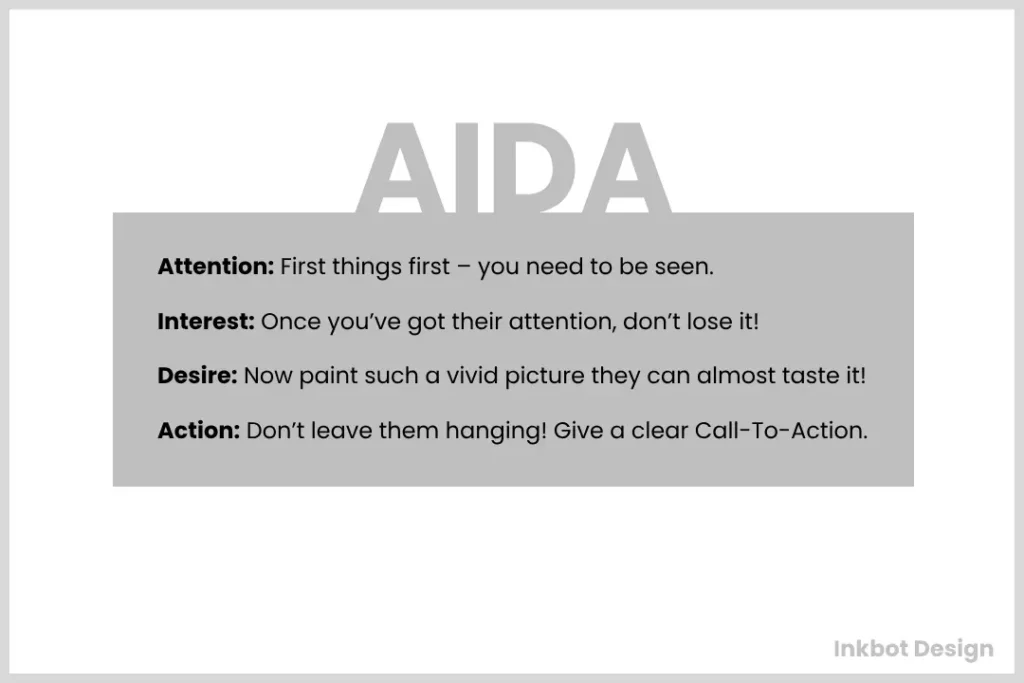
To begin with, let’s talk about the most popular copywriting formula: AIDA.
It does not refer to any lost opera but stands for Attention, Interest, Desire and Action. It is a classic created in the late 19th century and still effective today.
Attention: First things first – you need to be seen. With so many messages coming at us daily (more than a teenager’s phone), it’s crucial to stand out. You have got to open with something more substantial than a heavyweight punch.
Interest: Once you’ve got their attention, don’t lose it! This is where you start reeling people in with fascinating facts or relatable stories; ask questions that make them think long after reading your piece.
Desire: Now paint such a vivid picture they can almost taste it! Show how this will improve their life or make things easier for them…
Action: Don’t leave them hanging! Give clear and compelling Call-To-Action. Never assume they know what the next step should be; whether “Buy Now”, “Sign Up Today!” or “Call For Free Quote” – always let them know precisely what the next move should be.
Let’s illustrate how these steps could work together in real-life situations:
- Attention: “Tired of spending more time untangling your headphones than actually listening to music?”
- Interest: “Imagine never having to wrestle with a knotted mess again.”
- Desire: “Our new TangleFree earbuds use revolutionary cord technology to stay knot-free, no matter how carelessly you toss them in your bag.”
- Action: “Experience tangle-free bliss – order your pair today!”
The PAS Formula: Problem, Agitation, Solution
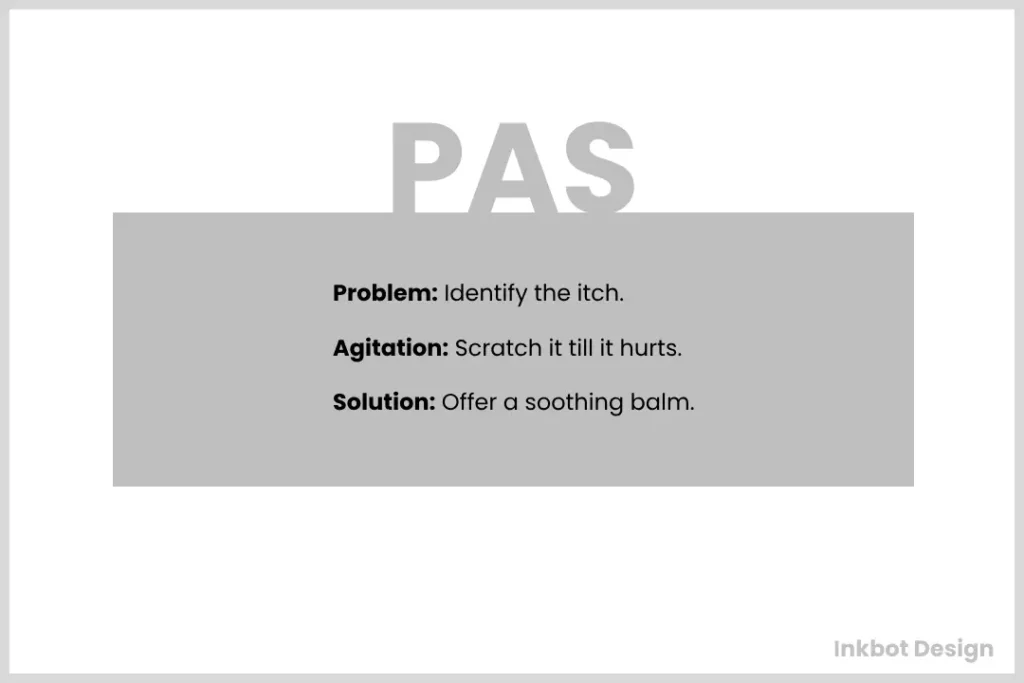
If AIDA is the classic rock of copywriting formulas, PAS is the blues. It taps into the reader’s pain points and offers sweet relief.
- Problem: Identify the itch. Start by highlighting a problem your audience faces. Make it clear you understand their struggles.
- Agitation: Scratch it till it hurts. Now, dig deeper. Remind them of all the ways this problem makes their life difficult. Twist the knife (gently, of course).
- Solution: Offer a soothing balm. Finally, swoop in with your product or service as the hero to make it all better.
PAS at Work For example, here’s PAS for a time-management app:
- Issue: “Feeling overwhelmed by your never-ending to-do list?”
- Problem: “Every day, tasks pile up. Important deadlines slip through the cracks. You’re working harder than ever but somehow always falling behind. The stress is taking a toll on your work and personal life.”
- Solution: Introducing TimeWrangler – an app that turns chaos into calmness by prioritising tasks, sending smart reminders and helping focus on what matters most in life; download TimeWrangler now!
The FAB Technique: Features, Advantages, Benefits
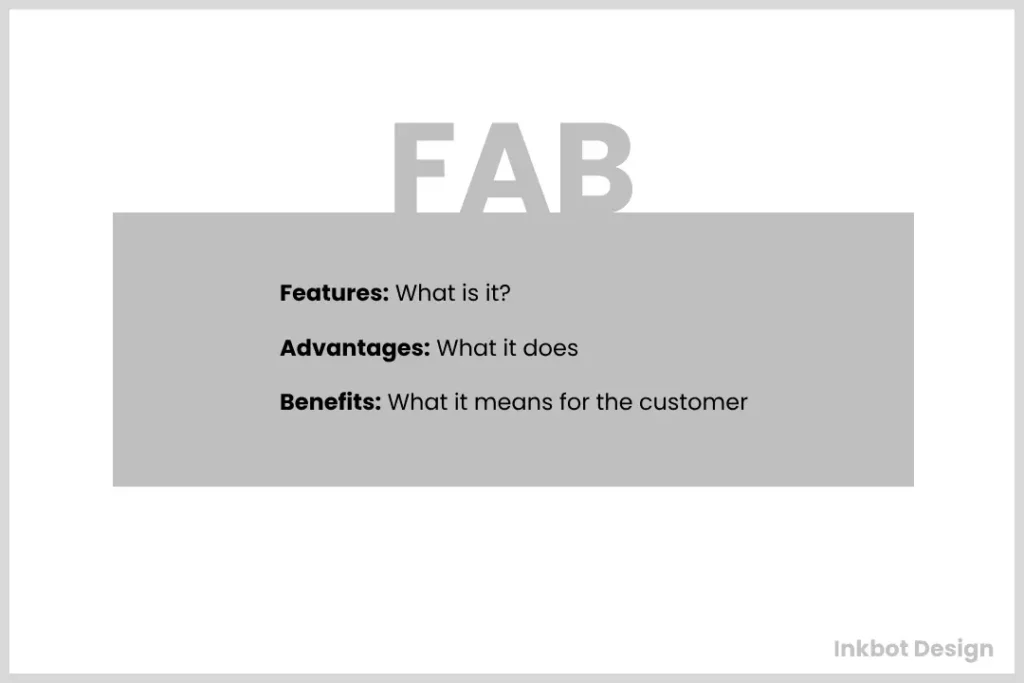
Sometimes, it is necessary to explain things simply to your readers. This is what FAB is designed for. It connects what the product does and why it matters to the consumer.
Dissecting FAB
- Features: What is it? List all the main characteristics or parts of your service or product.
- Advantages: What it does Explain how these features operate and what they achieve.
- Benefits: What it means for the customer Convert those advantages into real user benefits. How will this enhance their life?
Let’s take a high-tech umbrella as an example:
- Feature: “Constructed from advanced hydrophobic fabric”
- Advantage: “Repels water better than old-fashioned umbrellas.”
- Benefit: “Keeps itself dry and lightweight even during heavy downpours so you can have more comfortable rainy commutes.”
The 4 Cs: Clear, Concise, Compelling, Credible
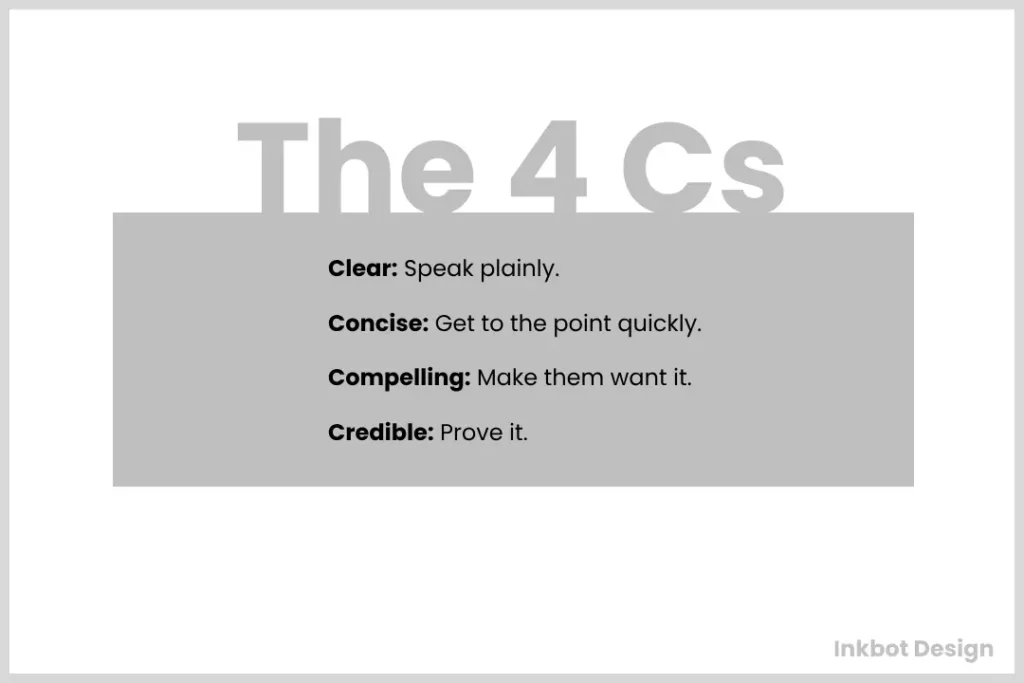
The 4 Cs formula can help you get heard in a world where attention spans decrease.
- Clear: Speak plainly. Ensure your message is so simple that even your grandma could understand it. No jargon, no fluff.
- Concise: Get to the point quickly. Every word should earn its place. Don’t waste time with unnecessary details.
- Compelling: Make them want it. Your copy must be more irresistible than the last cookie in the jar. Use strong language that appeals to both emotions and logic.
- Credible: Prove it. Back up what you say, and support your claims with evidence, testimonials, or hard facts. It would help if you built trust with your audience.
Here’s how an ad for a fitness program might look like through the lens of the 4Cs:
“Transform Your Body in 30 Days with FitFast (Clear). Our science-backed, 20-minute daily workouts produce fast results (Concise). You’ll get stronger, look leaner and have more energy than ever (Compelling). Join over ten thousand satisfied customers who’ve already changed their lives (Credible). Start Your FitFast Journey Today!”
The Before-After-Bridge (BAB) Formula

Sometimes, the best tactic to persuade people about your solution is to describe life before and after using it. And this is where the BAB formula comes into play.
- Before: Explain the current situation and your target audience’s problem or pain point.
- After: The ideal outcome. Describe how life will be when the problem is solved.
- Bridge: How to get there. Present your product or service to move from “Before” to “After.”
Let’s take a productivity course as an example:
- Before: “Each morning, you start with good intentions, but come midday, you’re swamped with emails, unexpected tasks and deadlines looming over you. Most days leave you stressed and feeling like you haven’t accomplished anything.”
- After: “Picture finishing every workday having checked off all your important tasks. You leave the office on time – with energy left over for yourself and your hobbies.”
- Bridge: “Our course ‘Productivity Powerhouse’ takes overwhelmed people from being out of control to being in control. By signing up now, you will go through practical techniques and personalised strategies that will teach you to prioritise well, manage time like a pro and achieve more within less time. Begin now and move towards living a productive, balanced life.”
The PASO Formula: Problem, Agitation, Solution, Outcome
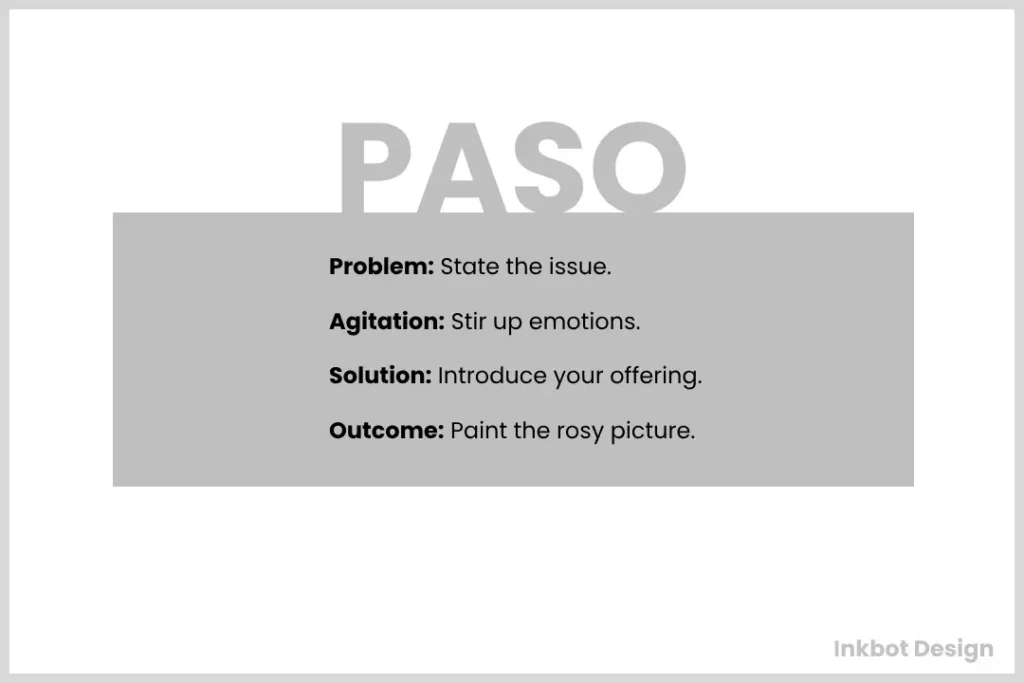
PASO is like the over-ambitious sister (or brother) of PAS. It further lets the reader know what happens if they follow your solution.
- Problem: State the issue. Describe a situation that your audience has faced as well.
- Agitation: Stir up emotions. Consider how it feels when you’re frustrated by not being able to fix things or make them better for yourself or others around you because of some obstacle standing in your way.
- Solution: Introduce your offering. Present an answer, which could be anything from products, services, ideas or even advice on what steps must be taken towards resolving issues.
- Outcome: Paint the rosy picture. Describe all good things people might expect after implementing this resolution into their lives or businesses’ routines so that they are more likely to take action now rather than later on down the line when everything seems fine again without doing anything about it – if only we had known earlier!
Here’s an example of using PASO to promote residential cleaning services:
- Problem: Is your house looking like a junkyard?
- Agitation: You work hard on weekdays but battle dust piles taller than Mount Everest every weekend. Seeing such messiness around stealing all those precious minutes you should be resting after long hours at work stresses you out!
- Solution: Get professional cleaners from SparkleHomeOur. Our skilled team will come over while you earn bread and butter; they won’t leave until everything shines brighter than diamonds!
- Outcome: Come back to spotless rooms filled with fresh air and take deep breaths in every corner, knowing no speck of dirt is left anywhere within eyesight range! Spend lazy Sundays indoors having fun with loved ones instead of scrubbing floors.
The Star-Chain-Hook Method
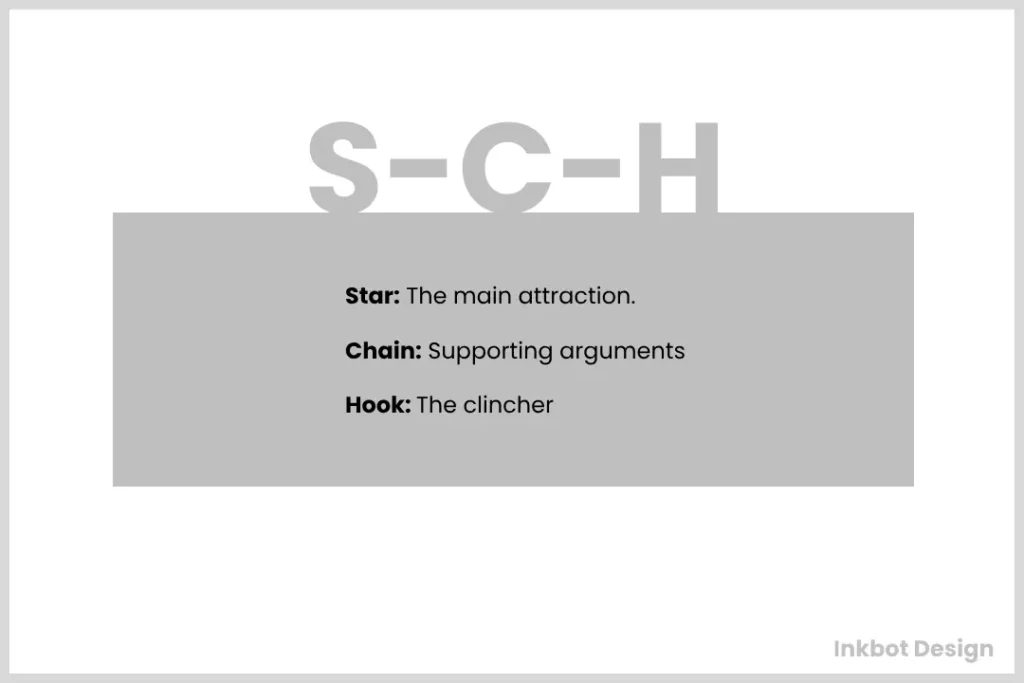
This structure is about storytelling. It’s as old as time but still works.
What does Star-Chain-Hook mean?
- Star: The main attraction. Start with your main point or offer – the star of the show.
- Chain: Supporting arguments: Link a series of supporting facts, benefits, or reasons to support your main point.
- Hook: The clincher End with a compelling call to action that reels the reader in.
For instance, suppose we are considering a language-learning app:
- Star: “With LinguaLeap, you can learn any language in 10 minutes daily!”
- Chain:
- Lessons scientifically designed for busy schedules.
- Fun interactive exercises that engage students’ interest and participation
- Perfect pronunciation using speech recognition technology
- Adaptable personalised learning paths according to learners’ progress and goals
- Real-world practice through interaction with native speakers
- Hook: “Begin your linguistic journey now! Download LinguaLeap free and unlock infinite opportunities around the globe!”
The ACCA Formula: Awareness, Comprehension, Conviction, Action
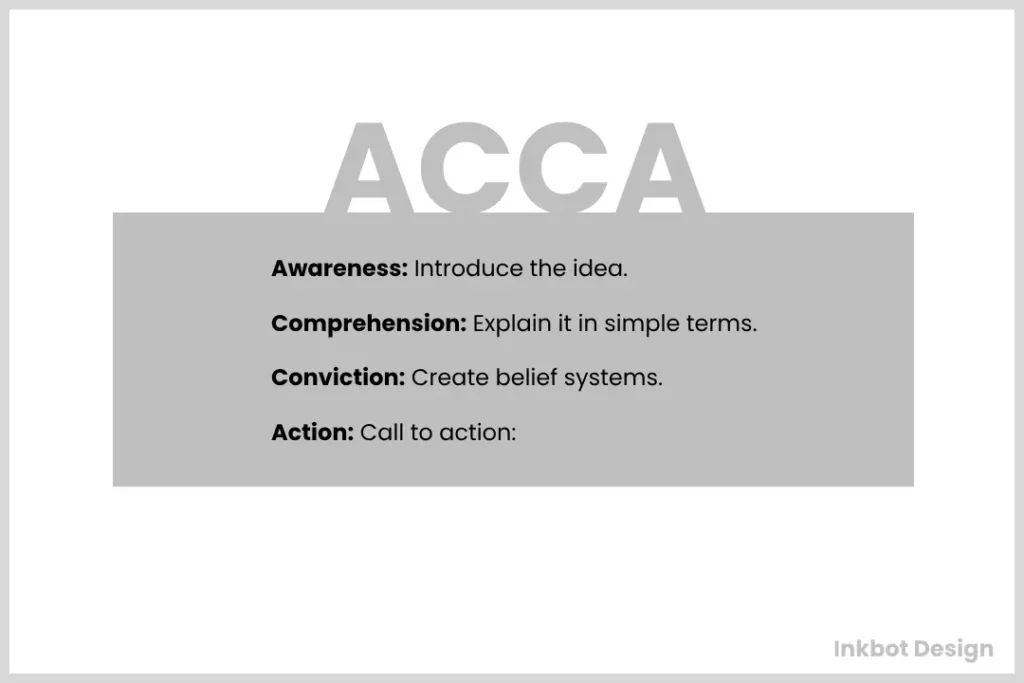
ACCA takes your audience on a journey of the mind, leading them from knowing to doing.
- Awareness: Introduce the idea. Make them recognise that there is something you are offering, whether it be a product, service or concept.
- Comprehension: Explain it in simple terms. Break down how it functions and why they should care about it.
- Conviction: Create belief systems. Show them why it’s necessary or valuable in their life according to what they already believe or know about themselves and other things around them (context).
- Action: Call to action: Give directions on the next steps towards achieving desired results with clear goals for each step.
Here’s an example of how ACCA might work with sustainable fashion brands:
- Awareness: “Introducing EcoThreads – where style meets sustainability.”
- Comprehension: “We make trendy, durable clothes from recycled materials only; we also use eco-friendly production methods. Each item is designed not to wear out fast, reducing garbage and reducing your carbon footprint.”
- Conviction: “When you opt for EcoThreads, you are not just updating fashion- but voting for cleaner earth too. On average, our clients save 1000 litres of water per garment and 20kg CO2 emissions against ordinary clothes.”
- Action: “Join the fashion revolution today – shop the new collection now & do good while looking good.”
The 6+1 Formula: Who, What, When, Where, Why, How + What If?
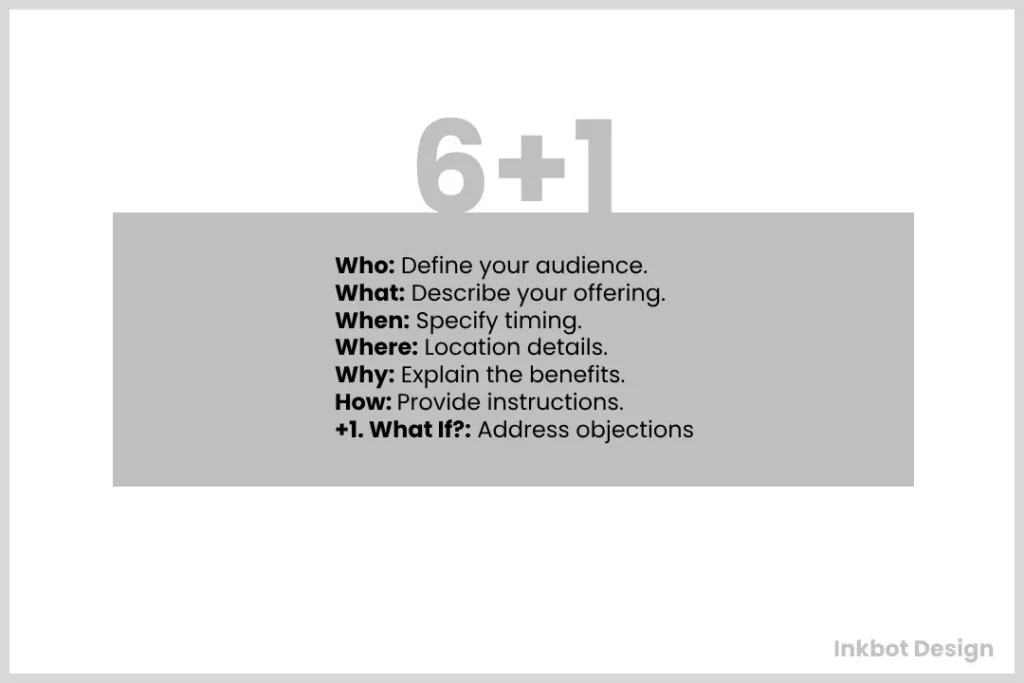
This formula is like the journalistic approach to copywriting, covering all the bases and then some.
- Who: Define your audience. Who is your product or service for?
- What: Describe your offering. What exactly are you selling?
- When: Specify timing. When should they buy or use it?
- Where: Location details. Where can they get it?
- Why: Explain the benefits. Why should they care?
- How: Provide instructions. How does it work, or how can they buy it?
+1. What If?: Address objections. What if they’re hesitating? Address potential concerns.
Let’s apply this to a fitness tracker:
- Who: “For health-conscious individuals looking to optimise their fitness journey”
- What: “The QuantumFit tracker – your personal health assistant.”
- When: “Start tracking your progress 24/7, with real-time updates and insights.”
- Where: “Available online and in select fitness stores nationwide.”
- Why: “Gain deep insights into your health, from sleep patterns to workout effectiveness, helping you achieve your fitness goals faster.”
- How: “Simply wear the sleek, waterproof device on your wrist and sync with our user-friendly app.”
- What If?: “Worried about privacy? QuantumFit uses bank-level encryption to keep your data secure and never shares your information without permission.
The QUEST Method: Qualify, Understand, Educate, Stimulate, Transition
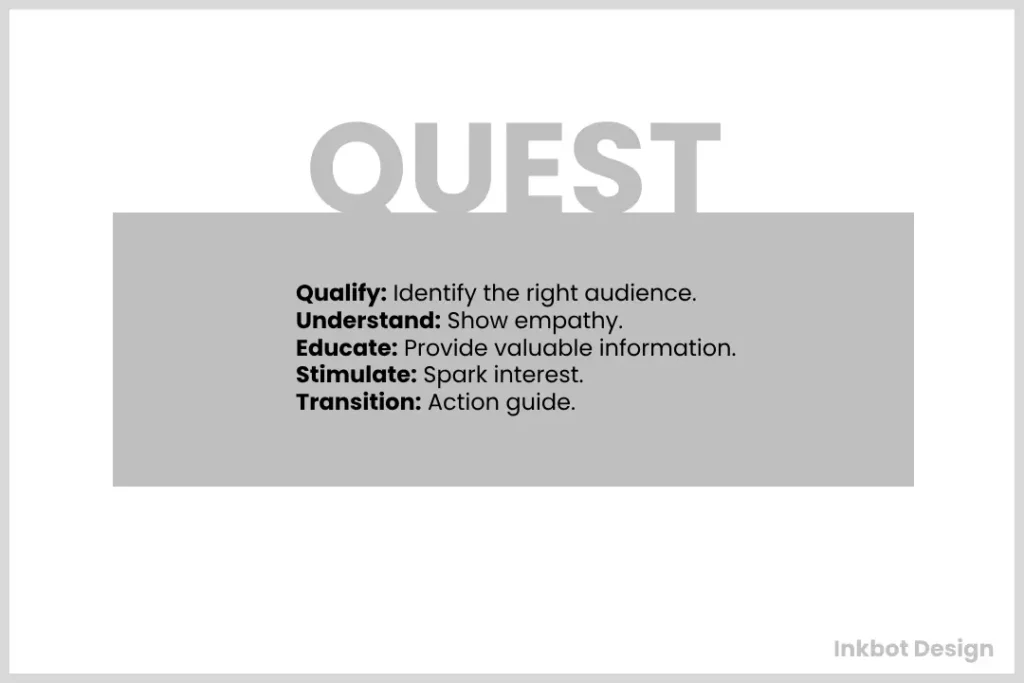
The objective of QUEST is to bring the audience along with you as they discover what’s possible and then call them to action.
- Qualify: Identify the right audience. Let them know who you are talking to so that they can determine if your product or service is for them.
- Understand: Show empathy. Make sure that you know what their pain points are.
- Educate: Provide valuable information. Teach them something new by giving insights into solutions related directly to their problem(s).
- Stimulate: Spark interest. Get people excited about the potential benefits of what you offer.
- Transition: Action guide: Help people take the following steps smoothly without making them feel pushed or rushed.
Here’s an example of how QUEST could be used with a financial planning service:
- Qualify: “Are you a young professional torn between paying off student loans and saving for retirement?”
- Understand: “We understand how hard it can be to juggle many different financial priorities at once – especially early on in one’s career.”
- Educate: “Were you aware that cutting back on spending even £5 per day could save over £1800 annually? Such changes may seem small but have a substantial impact over time.”
- Stimulate: “Think about having a “financial GPS” that lets us pay down our debts and put money aside for savings while enjoying those little luxuries. It’s not only doable – it’s easier than most think!”
- Transition: “Our team comprises expert advisers specialising in creating individualised plans for young professionals like yourselves looking forward to financial freedom. Schedule your FREE consultation now!”
The 4 U’s: Useful, Urgent, Unique, Ultra-specific
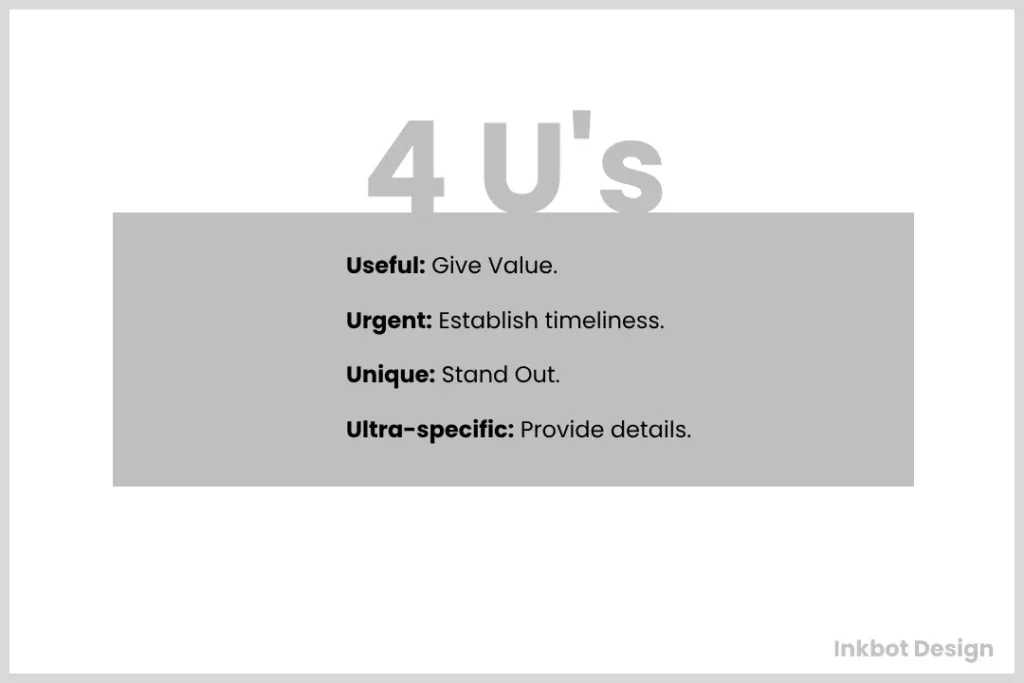
In a world with a lot of information, the four U’s can help your copy be more effective and make people act.
- Useful: Give Value. Your product or service should solve a problem or satisfy a real need.
- Urgent: Establish timeliness. Create an incentive for people to take action now rather than later.
- Unique: Stand Out. Explain what makes your offer different from (and better than) other solutions.
- Ultra-specific: Provide details. Use precise numbers, statistics and examples to build credibility and create a vivid image in someone’s mind.
Let’s look at how these principles could be used for weight loss:
- Useful: “Get rid of excess fat permanently using our scientifically proven methods, which focus on sustainable weight management.”
- Urgent: “You can lose up to 10kg before summer if you start today!”
- Unique: “Other programs crash diets that don’t work long term because they re-train metabolism too.”
- Ultra-specific: “Our average client loses between half a kilogram – one kilogram per week. According to recent studies, we found that after completing the course, 87% maintained their new weight for over twelve months.”
Putting It All Together: Mixing and Matching Formulas
Now that we’ve explored an array of copywriting formulas, you might wonder, “Do I have to pick just one?” The short answer is absolutely not! Some of the most effective copy comes from cleverly combining different formulas.
Think of these formulas as ingredients in your copywriting kitchen. Just as a master chef might combine techniques from French and Asian cuisine to create a unique fusion dish, you can blend different copywriting formulas to craft genuinely compelling content.
The Art of Formula Fusion
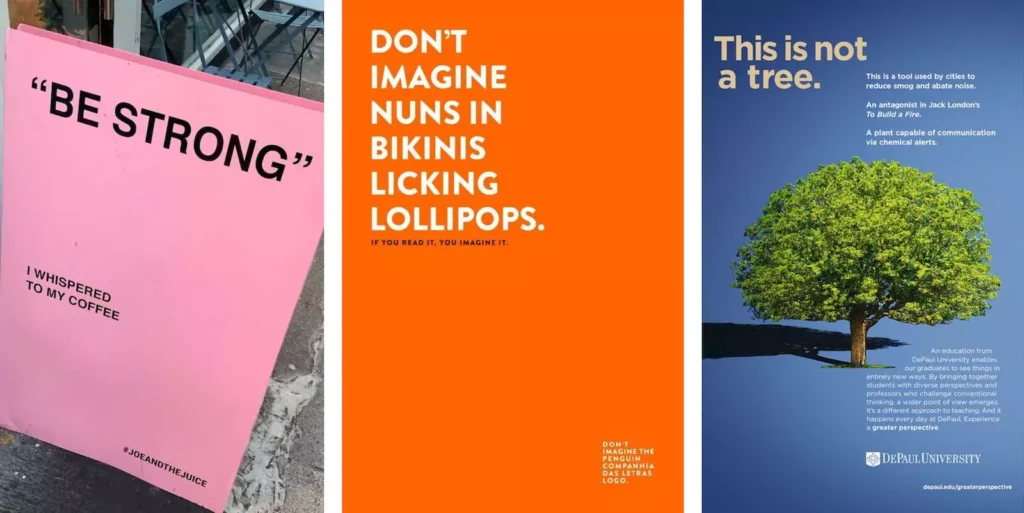
Here are some ways in which these formulas can be mixed and matched:
PAS with AIDA
Use the attention-grabbing element of AIDA but then move into a problem-agitation-solution (PAS) structure. You could start with a statement that captures attention, talk about a relatable problem to interest people, agitate that problem to create desire, and offer your solution with a clear call to action.
4 Cs plus FAB
While sticking to the Features-Advantages-Benefits formula as your core, ensure each point is clear, concise, compelling and credible (4 Cs). That way, you won’t just list dry facts but also package them so that they truly resonate with your readership.
BAB but QUEST-y
Begin with the Before-After-Bridge framework. Only this time around can it be infused with some elements of QUEST. Qualify your audience at the ‘before’ part, show empathy for their situation, then educate them on possible solutions during the ‘bridge’ stage; paint an enticing picture of what life could look like after they have taken action based on what you’re telling them now!
Comprehensive Persuasion = PASO + 6+1
Have PASO (Problem-Agitate-Solve-Outcome) as the main structure for this one, but also add some features from 6+1 to make it all-inclusive. This way, you can cover the emotional journey and practical details different individuals in your target group may require.
Adapting Formulas for Different Mediums
It’s important to remember that while these formulas are versatile, they may need tweaking depending on where and how you’re using them. Let’s explore how you might adapt your approach for different formats:
Social Media: Short and Sweet
You’ve got limited characters to play with on platforms like X or Instagram. Here, you might focus on just one or two formula elements. For instance, you could use the “Problem” and “Solution” from PAS, leaving out the “Agitation” to keep things concise.
Example tweet using a stripped-down PAS: “Tired of forgetting passwords? 🤯 LastPass remembers them all, so you don’t have to. Sign up for free today! #PasswordSecurity”
Email Marketing: The Long Game
With email, you have more space to develop your message. This is where you can flex your copywriting muscles and combine multiple formulas.
Subject line: Use AIDA to get them to open the email. “Unlock the secret to effortless productivity (and reclaim your weekends).”
Opening paragraph: Start with PAS to hook them in. “Ever feel like you’re drowning in to-do lists? You’re not alone. Millions of professionals struggle to keep up with mounting tasks, leading to stress, burnout, and missed opportunities.”
Body: Transition to FAB to showcase your solution. “Introducing TaskMaster Pro, the AI-powered productivity app, is revolutionising how people work.”
[Follow with a table of Features, Advantages, and Benefits]
Closing: Use BAB to paint a picture of transformation. “Imagine starting your day with clarity, ticking off tasks effortlessly, and ending with a sense of accomplishment. With TaskMaster Pro, that’s not just a dream – it’s your new reality.”
Call to Action: Finish strong with the ‘Action’ from AIDA. “Download TaskMaster Pro now and transform your productivity today!”
Landing Pages: The Full Monty
A landing page gives you room to use multiple formulas in their entirety. You might start with AIDA to structure the overall page, use PAS for each significant feature or pain point, sprinkle in some FAB to highlight key selling points, and close with a strong BAB to drive conversions.
Video Scripts: Storytelling Formulas Shine
Narrative-driven formulas like Star-Chain-Hook or Before-After-Bridge can be particularly effective for video content. These structures lend themselves well to visual storytelling and can help maintain viewer interest throughout the video.
The Human Touch: Beyond Formulas

These formulas are beneficial, but remember that they are tools, not rules. Excellent copy does not follow any formula, but it looks human.
Here’s how to give your writing a more human feel:
Know who you’re speaking to
Understanding your audience is vital. What do they care about? How do they speak? The better you can get to know them, the more naturally you can talk to them.
Find your voice
Every brand has a unique voice. Are you friendly and informal? Professional and authoritative? Quirky and fun? Whatever it is, let it shine through in your copy.
Tell stories
We’re wired for stories. So why not include some case studies or anecdotes in your copy? Or even just paint a hypothetical picture of what life could be like if…
Use conversational language
Imagine chatting to a friend – how would you explain it then? Use contractions, ask questions – don’t be afraid to be a little colloquial (if appropriate for your brand voice).
Inject some personality
A well-placed joke, pop culture reference or self-deprecating humour can warm people to your brand.
Be authentic
In an age of increasing cynicism, authenticity is everything. Be honest about what you can (and can’t) deliver with your product/service. Your audience will appreciate the transparency.
The Future of Copywriting Formulas
Copywriting has changed as we move on in the digital era. Even though these traditional patterns remain helpful, they are also being updated to cater to shifting consumer habits and technological improvements.
Micro-Moments
Google refers to those split-second decisions when people turn to their devices to act on a need as ‘micro-moments’. Copywriters have started developing ultra-short formulas to catch attention in such fleeting instances.
Voice Search Optimisation
Copywriters now write for more conversational and question-focused searches following the rise of voice assistants. Therefore, there is an increasing use of formulas that imitate natural speech patterns.
Personalisation at Scale
Copywriters can now think about personalising mass production thanks to AI and big data, which enables this. Therefore, They should find formulas that can stretch and change with individual user data.
Interactive Copywriting
A blurring line between UX design and copywriting ranges from the copy that varies depending on user interactivity to content in a choose-your-own-adventure format.
Ethical Persuasion
Regarding manipulative marketing strategies, customers are getting wiser by the day. The result is an increased focus on ethical persuasion, where transparency and genuine value are vital in any formula.
Conclusion: The Formula for Success
At the close of the day, copywriting formulas are the scales that musicians practice. They provide structure, help hit the correct notes and give a base for creativity. But great music is not just scales; likewise, excellent copy isn’t merely made up of formulas.
It becomes enchanting when you absorb these formulas from within, see them in light of your audience, and let your creative skills flow freely. Sometimes, you’ll follow one formula to the letter mix a few, and other times, you will still ignore all rules completely and write by instinct.
The trick is to keep learning new things, try different methods, and perfect what has already been learnt. Every written piece offers an opportunity for connection with another person through storytelling or problem-solving. That`s what truly makes copywriting an art form.
Therefore, take these rules but be guided by the humanity in all that you do because, in the end, words should do more than just sell – they must also inspire people to act upon their beliefs while educating them along the way; after all, good writing connects where others fail to reach out due lack of understanding each other`s points of view (communication).
Frequently Asked Questions
Are copywriting formulas essential? Can’t I just write in my own words?
They aren’t a must-have, but they are helpful. These provide an outline to guarantee that you touch on all the essential points and lead the reader to take action. Think of it as a safety net—they’re there for support, not restriction.
What is the best copywriting formula?
There isn’t a one-size-fits-all “best” formula. The effectiveness of a formula depends on your audience, product, medium and goals. It’s good to try different ones to see what works for you.
How do I know which formula to use for each project?
Consider your goals, audience and medium. For example, AIDA might work well for short-form ads, while longer formats like landing pages could benefit from a more comprehensive PASO or 6+1.
Can I include multiple formulas in one piece of copy?
Absolutely! Combining formulas often makes for a more substantial copy. Just make sure it flows naturally and doesn’t feel forced or repetitive.
Do these only work with certain types of products/services?
Although versatile, some may fit better than others, depending on what you’re selling. For instance, PAS (Problem-Agitation-Solution) tends to be effective when marketing things that solve an obvious problem, while FAB (Features-Advantages-Benefits) can showcase innovation nicely.
How do I avoid sounding robotic when using these templates?
Use them as guidelines rather than strict blueprints; read aloud after drafting with a template— if it sounds awkward, try rephrasing/reordering parts while keeping the overall structure intact.
Do these still apply, given social media/short attention spans?
Absolutely. While you may need to adapt them for shorter formats, the psychological principles underlying these formulas are still very much applicable today — structured persuasive writing has never been more necessary in an age where we’re bombarded by information every second.
How often should I use the same one?
Consistency is good, but variety keeps things interesting. Mix it up if writing multiple pieces for the same audience.
Can they be used in other types of writing besides just copywriting?
Some can be adapted to different kinds of writing— e.g., AIDA could structure a speech, and PAS might work well for specific essays or articles.
How do I know which formula performed better than another?
Test. Use different ones in an A/B test and measure metrics like CTRs (click-through rates), conversions or engagement over time to see what resonates most with your audience.

